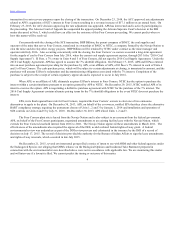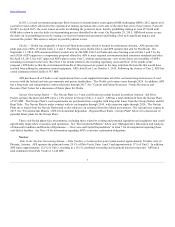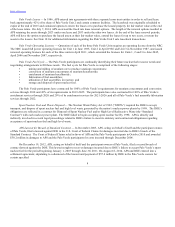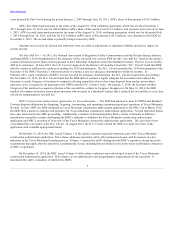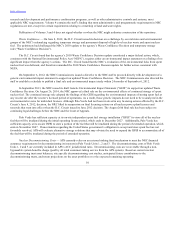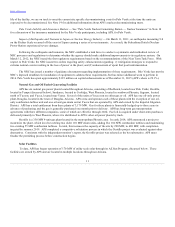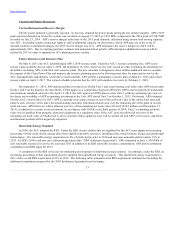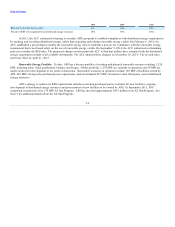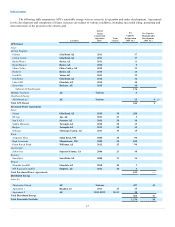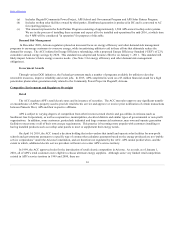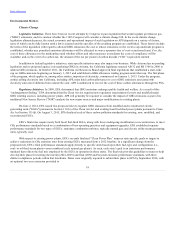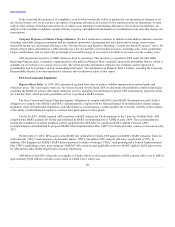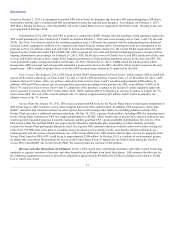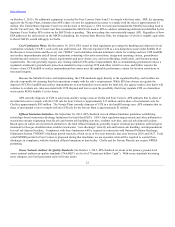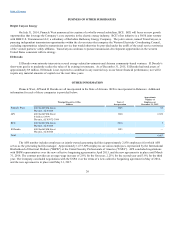APS 2015 Annual Report Download - page 19
Download and view the complete annual report
Please find page 19 of the 2015 APS annual report below. You can navigate through the pages in the report by either clicking on the pages listed below, or by using the keyword search tool below to find specific information within the annual report.
Table of Contents
(a) Includes Flagstaff Community Power Project, APS School and Government Program and APS Solar Partner Program.
(b) Includes rooftop solar facilities owned by third parties. Distributed generation is produced in DC and is converted to AC
for reporting purposes.
(c) This amount represents the Solar Partner Program consisting of approximately 1,500 APS-owned rooftop solar systems.
We are in the process of installing these systems and expect all to be installed and operational by mid-2016, at which time
the 9 MW will be considered "in operation" for purposes of this table.
Demand Side Management
In December 2009, Arizona regulators placed an increased focus on energy efficiency and other demand side management
programs to encourage customers to conserve energy, while incentivizing utilities to aid in these efforts that ultimately reduce the
demand for energy. The ACC initiated its Energy Efficiency rulemaking, with a proposed Energy Efficiency Standard (“EES”) of 22%
cumulative annual energy savings by 2020. This standard was adopted and became effective on January 1, 2011. This standard will
likely impact Arizona’s future energy resource needs. (See Note 3 for energy efficiency and other demand side management
obligations).
Government Awards
Through various DOE initiatives, the Federal government made a number of programs available for utilities to develop
renewable resources, improve reliability and create jobs. In 2015, APS completed its work on a $3 million financial award for a high
penetration photovoltaic generation study related to the Community Power Project in Flagstaff, Arizona.
Competitive Environment and Regulatory Oversight
Retail
The ACC regulates APS’s retail electric rates and its issuance of securities. The ACC must also approve any significant transfer
or encumbrance of APS’s property used to provide retail electric service and approve or receive prior notification of certain transactions
between Pinnacle West, APS and their respective affiliates.
APS is subject to varying degrees of competition from other investor-owned electric and gas utilities in Arizona (such as
Southwest Gas Corporation), as well as cooperatives, municipalities, electrical districts and similar types of governmental or non-profit
organizations. In addition, some customers, particularly industrial and large commercial customers, may own and operate generation
facilities to meet some or all of their own energy requirements. This practice is becoming more popular with customers installing or
having installed products such as rooftop solar panels to meet or supplement their energy needs.
On April 14, 2010, the ACC issued a decision holding that solar vendors that install and operate solar facilities for non-profit
schools and governments pursuant to a specific type of contract that calculates payments based on the energy produced are not “public
service corporations” under the Arizona Constitution, and are therefore not regulated by the ACC. APS cannot predict when, and the
extent to which, additional electric service providers will enter or re-enter APS’s service territory.
In 1999, the ACC approved rules for the introduction of retail electric competition in Arizona. As a result, as of January 1,
2001, all of APS’s retail customers were eligible to choose alternate energy suppliers. Although some very limited retail competition
existed in APS’s service territory in 1999 and 2000, there are
16


